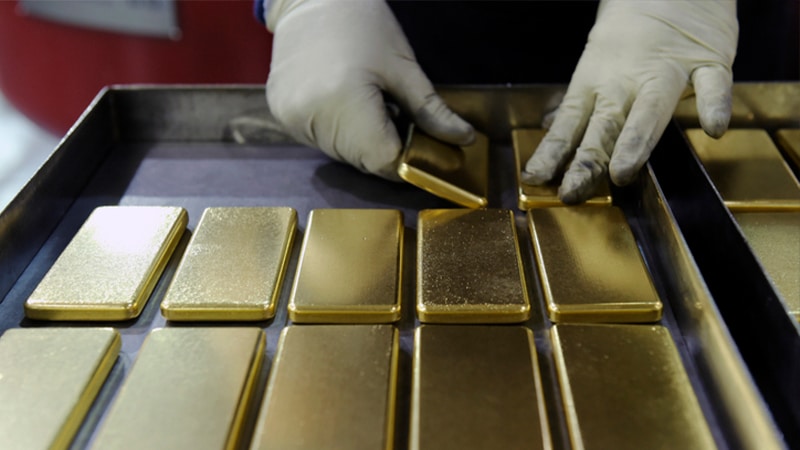Gold prices are forecast to rise another 8% this year


The price of gold has surged more than 40% since the start of January 2024, repeatedly shattering records. Goldman Sachs Research forecasts the rally in gold will continue amid demand from central banks.
The price of the precious metal is predicted to climb a further 8% to $3,100 a troy ounce by the end of 2025, analyst Lina Thomas writes in the team’s report. (The team’s previous projection was for gold to rise to $2,890.)
The increased forecast is underpinned by higher-than-expected demand for gold from central banks, which have been increasing their reserves of the commodity since the freezing of Russian central bank assets in 2022, following Russia’s invasion of Ukraine.
As well as stronger central bank demand, Goldman Sachs Research anticipates a boost to the gold price from increased purchases of gold ETFs as declining interest rates make gold a more attractive investment.
Those factors may be somewhat offset by speculators reducing their net long positions on gold in futures markets, which is projected by Goldman Sachs Research to weigh on the gold price somewhat. Net long positions are currently very high as concerns of sustained tariffs from the Trump administration drive investors towards safe haven assets including gold.
But continued uncertainty — whether it’s about tariffs, geopolitical risk, or fears about high government borrowing — could also push speculators to increase their long positions in gold. This scenario would drive the gold price as high as $3,300 per troy ounce by the end of 2025, Thomas writes in the report.
Our analysts’ gold price prediction
The main driver of the higher forecast is central bank buying, which exceeded expectations in December.
Before the freezing of Russian central bank assets in 2022, the average monthly institutional demand on the London over-the-counter gold market stood at 17 tonnes. In December last year, that figure hit 108 tonnes.
Thomas estimates that demand from central banks alone on the London OTC gold market increased fivefold following the freezing of Russian central bank assets. As a result, she says, the team has increased the assumption for central bank demand in its gold price forecast.
Consistently higher demand from central banks could raise the gold price by as much as 9%, Thomas adds.
Goldman Sachs economists also expect the Federal Reserve to cut interest rates twice this year, which should provide an additional lift to the gold price as non-interest-bearing assets start to look more attractive relative to bonds.
These two dynamics should outweigh the anticipated drag on the gold price from speculators offloading their unusually high net long positions in the yellow metal on futures markets. Speculators’ net long positions are high because of demand for gold as a safe haven asset — a phenomenon that could be short lived if markets become more certain about the economic and political environment. A return to more normal levels of long positions among speculators could weigh on the gold price in the short term — which could make it a less attractive time for investors to enter the market — but the price is still likely to trend upwards by the end of the year, according to the report.
What are the risks to the new price forecast?
Several factors could cause the gold price to either undershoot or exceed Goldman Sachs Research’s projection for gold to rise to $3,100 per troy ounce by the end of year.
On balance, these risks are to the upside — they are more likely to drive the price higher than forecast. For example, if policy uncertainty remains elevated or sustained concerns about tariffs continue to drive demand for safe haven assets, the team predicts that speculative gold investing could push prices as high as $3,300 by December 2025.
“We also see upside risk to our gold price forecast from stronger-than-expected central bank demand on higher US policy uncertainty,” Thomas writes. If purchasing by central banks hits 70 tonnes per month on average, gold prices could climb as high as $3,200 by the end of 2025, she adds.
Similarly, an increase in concerns over the trajectory of US government debt could drive central banks with large US Treasury reserves to buy more gold, as well as driving speculative positioning and ETF flows higher, which could provide an additional 5% rise in prices by the end of the year, bringing them to $3,250.
Gold prices could fall short of the new forecast if the Fed cuts US interest rates less than our analysts expect. For example, if the Fed keeps rates flat, the team expects the gold price to reach only $3,060 per troy ounce by the end of 2025.
This article is being provided for educational purposes only. The information contained in this article does not constitute a recommendation from any Goldman Sachs entity to the recipient, and Goldman Sachs is not providing any financial, economic, legal, investment, accounting, or tax advice through this article or to its recipient. Neither Goldman Sachs nor any of its affiliates makes any representation or warranty, express or implied, as to the accuracy or completeness of the statements or any information contained in this article and any liability therefore (including in respect of direct, indirect, or consequential loss or damage) is expressly disclaimed.
Our signature newsletter with insights and analysis from across the firm
By submitting this information, you agree that the information you are providing is subject to Goldman Sachs’ privacy policy and Terms of Use. You consent to receive our newletter via email.